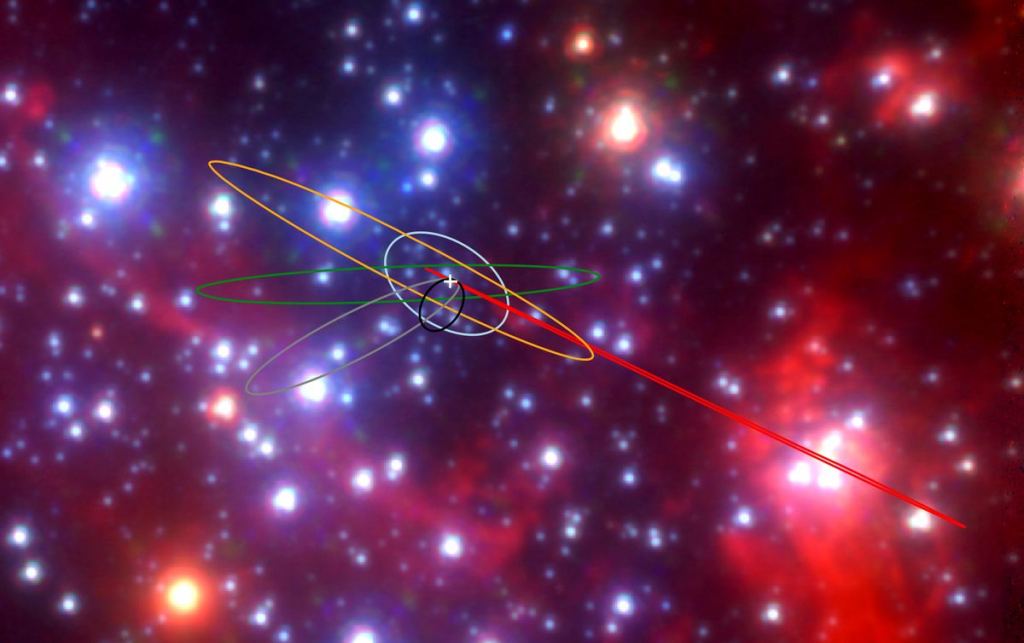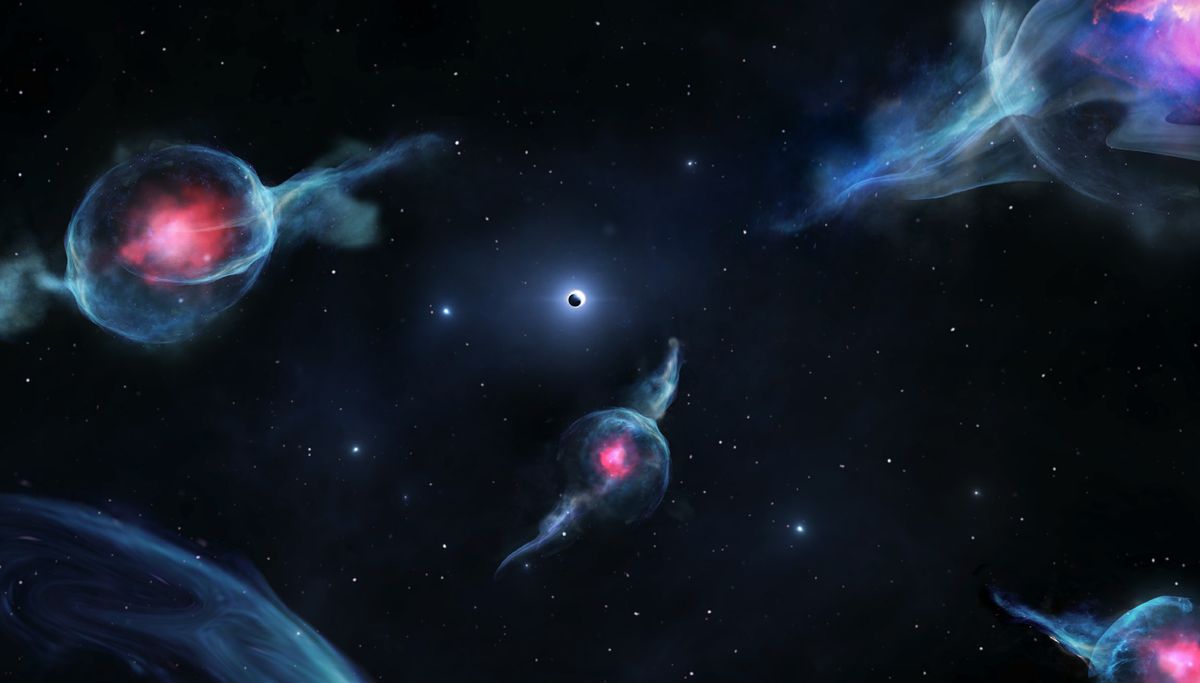At the center of our galaxy lies a region where roughly 10 million stars are packed into just 1 parsec (3.25 light-years) of space. At the center of this lies the supermassive black hole (SMBH) known as Sagittarius A*, which has a mass of over 4 million Suns. For decades, astronomers have been trying to get a better look at this region in the hopes of understanding the incredible forces at work and how they have affected the evolution of our galaxy.
What they’ve found includes a series of stars that orbit very closely to Sagittarius A* (like S1 and S2), which have been used to test Einstein’s Theory of General Relativity. And recently, a team from UCLA’s Galactic Center Orbits Initiative detected a series of compact objects that also orbit the SMBH. These objects look like clouds of gas but behave like stars, depending on how close they are in their orbits to Sagittarius A*.
The study that describes their findings, which recently appeared in the journal Nature, was led by Dr. Anna Ciurlo of the University of California, Los Angeles (UCLA). As they indicate in their study, these objects orbit our galaxy’s SMBH with a period of between 100 to 1,000 years. These objects look compact most of the time but stretch out when they are at the closest point in their orbits to the black hole.

Their work builds on about fifteen years of observations that have identified more and more of these objects near the center of our galaxy. The first object (later named G1) was discovered in 2005 by a team led by Andrea Ghez, the Lauren B. Leichtman and Arthur E. Levine Professor of Astrophysics the director of the UCLA Galactic Center Group and a co-author on this study.
This was followed in 2012 when Prof. Ghez and her colleagues found a second object (G2) that made a close approach to Sagittarius A* in 2014. Initially, G1 and G2 were thought to be gas clouds until they made their closest approach to the Sagittarius A*s and were not shredded by the SMBHs gravitational pull (which is what happens normally to gas clouds when approaching a black hole). As Ghez explained:
“At the time of closest approach, G2 had a really strange signature. We had seen it before, but it didn’t look too peculiar until it got close to the black hole and became elongated, and much of its gas was torn apart. It went from being a pretty innocuous object when it was far from the black hole to one that was really stretched out and distorted at its closest approach and lost its outer shell, and now it’s getting more compact again.”
In 2018, Dr. Cuirlo and an international team of astronomers (which included Prof. Ghez) used twelve years of data gathered by the W.M. Keck Observatory and adaptive optics technology (which Prof. Ghez helped pioneer) to identify three more of these objects (G3, G4, and G5) near the galaxy’s center. Since that time, a total of six objects have been identified in this region (G1 – G6).
In this most recent study, the team led by Dr. Cuirlo used 13 years of near-infrared data obtained by the W.M. Keck’s OSIRIS integral field spectrometer to examine the orbits of these six objects. Astronomers are exciting to study these objects because they provide astronomers with an opportunity to test General Relativity – something which Prof. Ghez and her colleagues did in the summer of 2019.
And as Mark Morris – a UCLA professor of physics and astronomy and a co-author on the study – explained, the fate of these objects is something astronomers want to know because it expected to be quite spectacular.
“One of the things that has gotten everyone excited about the G objects is that the stuff that gets pulled off of them by tidal forces as they sweep by the central black hole must inevitably fall into the black hole,” he said. “When that happens, it might be able to produce an impressive fireworks show since the material eaten by the black hole will heat up and emit copious radiation before it disappears across the event horizon.”
In the course of observing the Milky Way’s central region, the research group has reported the existence of six objects so far. However, they also noticed that while G1 and G2 have very similar orbits, the other four objects’ differ considerably. This naturally gives rise to the question of whether all six are a similar class of objects, or G1 and G2 are outliers.
Addressing this, Ghez and her colleagues believe that all six objects were binary stars that merged because of the SMBHs strong gravitational force. This process would have taken more than 1 million years to complete and could be an indication that binary star mergers are actually quite common. As Ghez explained:
“Black holes may be driving binary stars to merge. It’s possible that many of the stars we’ve been watching and not understanding may be the end product of mergers that are calm now. We are learning how galaxies and black holes evolve. The way binary stars interact with each other and with the black hole is very different from how single stars interact with other single stars and with the black hole.”
Another interesting observation, which Ghez’s team reported on back in September of 2019, is the fact that Sagittarius A* has been growing brighter in the past 24 years – an indication that it is consuming more matter. Similarly, the stretching of G2 that was observed in 2014 appeared to pull gas away from it that may have been recently consumed by the black hole.
This could be an indication that the stellar mergers taking place in its vicinity are feeding Sagittarius A*. The most recent observations also showed that while the gas from G2’s outer shell was stretched dramatically, the dust contained inside did not get stretched much. This means that something kept the dust compact, which is compelling evidence that star could be inside G2.
As Ciurlo said, this discovery was made possible thanks to decades’ worth of observations by the UCLA Galactic Center Group.
“The unique dataset that Professor Ghez’s group has gathered during more than 20 years is what allowed us to make this discovery. We now have a population of ‘G’ objects, so it is not a matter of explaining a ‘one-time event’ like G2.”
Meanwhile, the team has already identified a few other candidates that could belong to this new class of objects and are continuing to analyze them. Ultimately, this research will help astronomers to understand what is happening in the majority of galaxies and how interactions between stars and SMBHs in their cores are helping to drive their evolution.
“The Earth is in the suburbs compared to the center of the galaxy, which is some 26,000 light-years away,” said Ghez. “The center of our galaxy has a density of stars 1 billion times higher than our part of the galaxy. The gravitational pull is so much stronger. The magnetic fields are more extreme. The center of the galaxy is where extreme astrophysics occurs – the X-sports of astrophysics.”


So we are seeing a star get stretched out by the SMBH and we are getting epileptic about it? Sometimes a star is just a star. And a SMBH is just behaving the way we would think a SMBH is supposed to behave. But let’s call them “G” objects. It makes more sense than redefining a star that is being stretched by a SMBH. Duh…
A star’s very existence is a balancing act between gravity and pressure . The tremendous tidal forces of a 4m MSun singularity must have a profound effect on that hydrostatic equilibrium, and possibly the physics of fusion itself so the ability of these objects to maintain any kind of stability in that environment is surely worthy of a bit of scientific enthusiasm.